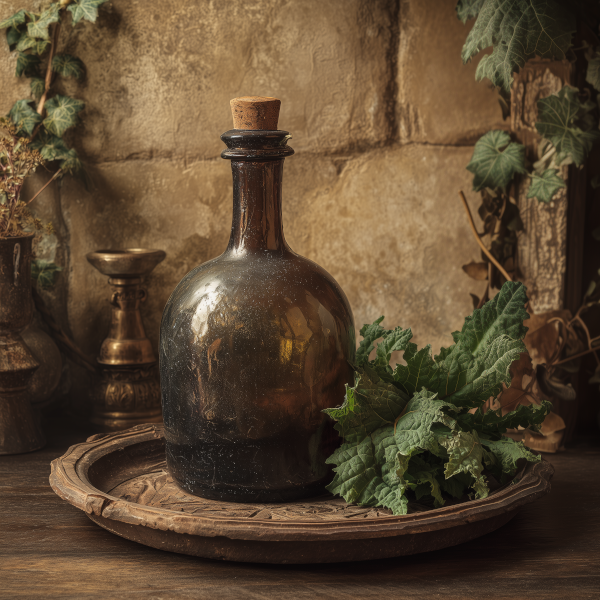Stonebrine Vinegar
Stonebrine smoky, dark, and deep,Foremost among the culinary fare of the northern district of Gression is the condiment that accompanies most dining experiences. Stonebrine vinegar, or simply stonebrine, is a tart and tangy concoction with a distinctive smoky aroma that is instantly recognizable. Created from local stoneberries and winter rye, it has a variety of uses, both culinary and medicinal. The liquid keeps for years in cool storage areas like root cellars or buried caches, although it rarely lasts that long.
Wakes the meal from winter sleep.
History
Stonebrine most likely began as a preservation agent. Sour berries and juice that were mixed with salt lichen and left in the warmth created a rough version of the vinegar. This liquid helped meat and vegetables to last longer. Over the years, as the fermenting process was refined, people began experimenting with herbal additives, especially toasted or smoked herbs, to mask the bitter notes of the brew. Leftover grain mash was also added to give the liquid more body and nutrition, as well as to use up leftovers. As the flavor was refined, folks began using it not just as a preservative, but as a condiment. Its smoky, sharp taste was ideal for spicing up bland winter fare such as roots and frostkin kale. Today, every household takes time before the first frost to harvest wild stoneberries and ferment batches for the next year's stonebrine.Culinary Uses
In addition to its role as a preserving agent for cured meat, bitter greens, eggs, and many other foods, stonebrine has many uses in daily meal preparation. The tangy vinegar is often added as a late ingredient to soups and stews, to lighten the dish and include its own unique flavor. Oftentimes, stonebrine is drizzled or spread over rye breads as a substitute for butter. Most of all, one will find stonebrine on every table, as a garnish mixed with oil for leafy salads, as extra salt or flavoring in a dish, or as an added kick to meats and cheeses. The vinegar is used sparingly, but often, and its scent is often associated with hearth and home in Gression.Medicinal Uses
Many remedies exist that use stonebrine in whole or in part, mostly as proof against the harsh northern cold. Diluted stonebrine is gently rubbed onto frostbite to aid in warming the flesh, or drunk hot to ward off the early stages, and general chill. Coughs and colds are often treated with a mixture of warm stonebrine, honey, and rosemary or pine tea. Elders often take a spoonful of it as a digestive aid, as well. The antibacterial and antifungal properties of stonebrine make it an excellent choice to clean wounds, and a very diluted solution is typically used as a cleaning agent around the house.Exports
With its unique flavor profile and versatility, stonebrine has gathered a small but loyal market among the noble families in the south of Polira. The vinegar is produced commercially and exported by a family in the town of Frostrun, under the name of Cendrevin. The merchants ship approximately 250 gallons of stonebrine a year, in kegs and smaller stoneware crocks, to southern settlements. Difficulties with shipping routes, weather, and transport keep the business small, and the prices high.Crafted from wild stoneberries and aged with fragrant herbs, it brightens hearty meals and brings a taste of rugged tradition to any table. Once you’ve tried Stonebrine, no dish feels quite complete without it.
Rare in other areas of Polira.
Typical Recipe
Ingredients
- 8 gills of tart stoneberries
- 4 gills of winter rye mash, coarsely ground and fermented several days
- 1 sprig of juniper or pine, lightly charred
(Can use dried sage in a pinch) - 2 gills of starter vinegar from last year’s batch or spoonful of sourdough starter
- A small handful of salt lichen ash — or else smoked salt and fine wood ash
- Clean spring water, enough to cover the mixture
Preparation
- Gently bruise the stoneberries in a wooden bowl, leaving the flesh whole
- Mix the bruised berries with the winter rye mash in a large vessel
- Add the starter vinegar and enough lukewarm water to just cover the mix
- Hold the fresh rosemary sprig over the embers until it smokes softly; then add whole to mixture
- Cover the vessel with a clean linen cloth, tied loosely, and set the vessel by the hearth or a warm corner
- Stir with a stick carved from juniper or ash each day for a week or two
- When the mixture bubbles and gives forth a sharp, smoky scent, strain the solids through a cloth
- Stir in the salt lichen ash, blending its taste well
- Bottle in dark flasks or jars, sealing tight with beeswax or cloth







Great answer to the prompt, kudos for adding precise instructions ! It's both precise and comfortable to read, I had no difficulty picturing a smell in my mind